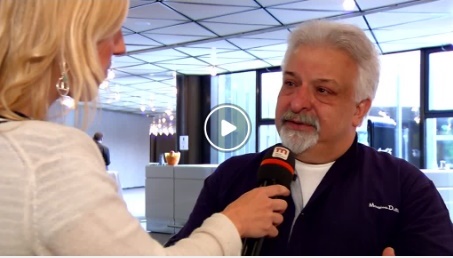Video Interview with the CEO of this Portal at K-Preview 2016
A. A. Saatnia works as a journalist for a long time in Iran. Right now he is also the CEO and Founder of Polymer Industry Media International. This year 3D printing will be an important theme for Iran at the K, because right now they are able to perform in the 3D business and receive good cooperation.
Watch the videos of the K-Preview
The trade fair “K” opens in Düsseldorf from the 19 to 26 October presenting the innovations of the international plastics and rubber industry.
What is 3D printing?
3D printing or additive manufacturing is a process of making three dimensional solid objects from a digital file.
The creation of a 3D printed object is achieved using additive processes. In an additive process an object is created by laying down successive layers of material until the object is created. Each of these layers can be seen as a thinly sliced horizontal cross-section of the eventual object.
How does 3D printing work?
It all starts with making a virtual design of the object you want to create. This virtual design is for instance a CAD (Computer Aided Design) file. This CAD file is created using a 3D modeling application or with a 3D scanner (to copy an existing object). A 3D scanner can make a 3D digital copy of an object.
3D scanners
3D scanners use different technologies to generate a 3D model. Examples are: time-of-flight, structured / modulated light, volumetric scanning and many more.
Recently, companies like Microsoft and Google enabled their hardware to perform 3D scanning, for example Microsoft’s Kinect. In the near future digitising real objects into 3D models will become as easy as taking a picture. Future versions of smartphones will probably have integrated 3D scanners.
Currently, prices of 3D scanners range from expensive professional industrial devices to $30 DIY scanners anyone can make at home.
3D modeling software
3D modeling software also comes in many forms. There’s industrial grade software that costs thousands a year per license, but also free open source software, like Blender, for instance.
When you are a beginner and the amount of choices are a bit overwhelming, we recommend to start with Tinkercad. Tinkercad has a free version and it works in browsers that support WebGL, for instance Google Chrome. They offer beginner lessons and has a built in option to get your object printed via various 3D printing services.
When you have a 3D model, the next step is to prepare it in order to make it 3D printable.
From 3D model to 3D Printer
You will have to prepare a 3D model before it is ready to be 3D printed. This is what they call slicing. Slicing is dividing a 3D model into hundreds or thousands of horizontal layers and needs to be done with software.
Sometimes a 3D model can be sliced from within a 3D modeling software application. It is also possible that you are forced to use a certain slicing tool for a certain 3D printer.
When the 3D model is sliced, you are ready to feed it to your 3D printer. This can be done via USB, SD or wifi. It really depends on what brand and type 3D Printer you have.
When a file is uploaded in a 3D printer, the object is ready to be 3D printed layer by layer. The 3D printer reads every slice (2D image) and creates a three dimensional object.
How to learn 3D Printing
You could start your journey in learning 3D printing by following this Coursera course. It costs around $350 USD.
For the same price however you can choose to assemble your own 3D Printer kit. This way you’ll gradually learn al the keywords which will help you repairing / adjusting your 3D printer when necessary.
If you are interested in going this route, please read our article about cheap 3D printer kits. This article explains what to look for when you’re comparing these kits.
Processes and technologies
Not all 3D printers use the same technology. There are several ways to print and all those available are additive, differing mainly in the way layers are build to create the final object.
Some methods use melting or softening material to produce the layers. Selective laser sintering (SLS) and fused deposition modeling (FDM) are the most common technologies using this way of 3D printing. Another method is when we talk about curing a photo-reactive resin with a UV laser or another similar power source one layer at a time. The most common technology using this method is called stereolithography (SLA).
To be more precise: since 2010, the American Society for Testing and Materials (ASTM) group “ASTM F42 – Additive Manufacturing”, developed a set of standards that classify the Additive Manufacturing processes into 7 categories according to Standard Terminology for Additive Manufacturing Technologies. These seven processes are:
- Vat Photopolymerisation
- Material Jetting
- Binder Jetting
- Material Extrusion
- Powder Bed Fusion
- Sheet Lamination
- Directed Energy Deposition
Below you’ll find a short explanation of all of seven processes for 3D printing:
Vat Photopolymerisation
A 3D printer based on the Vat Photopolymerisation method has a container filled with photopolymer resin which is then hardened with UV light source.














